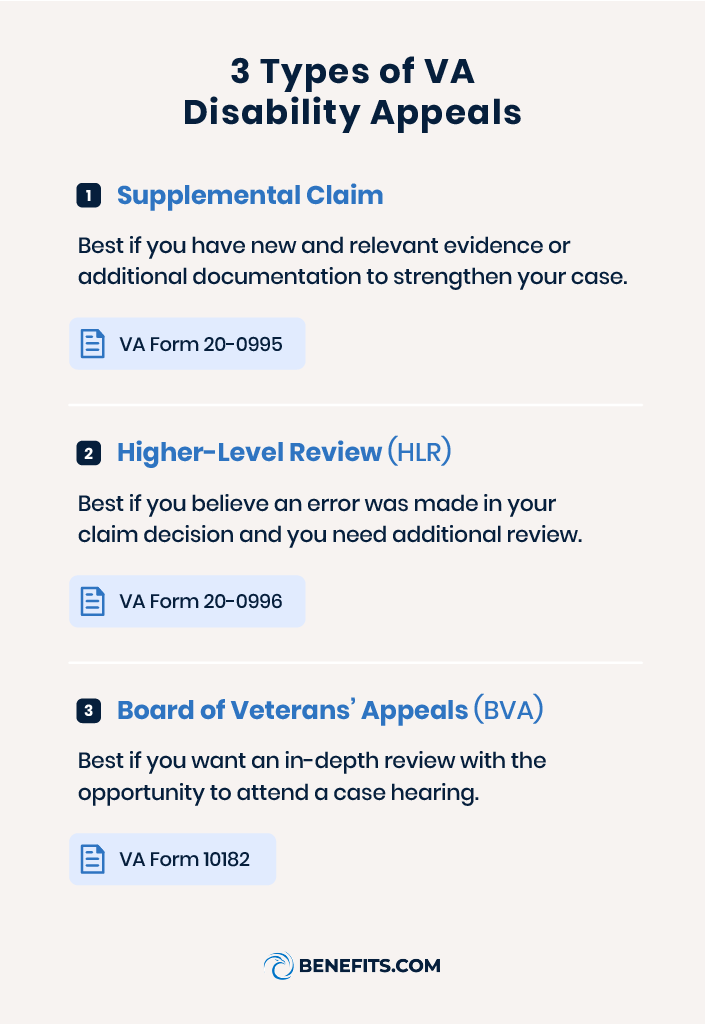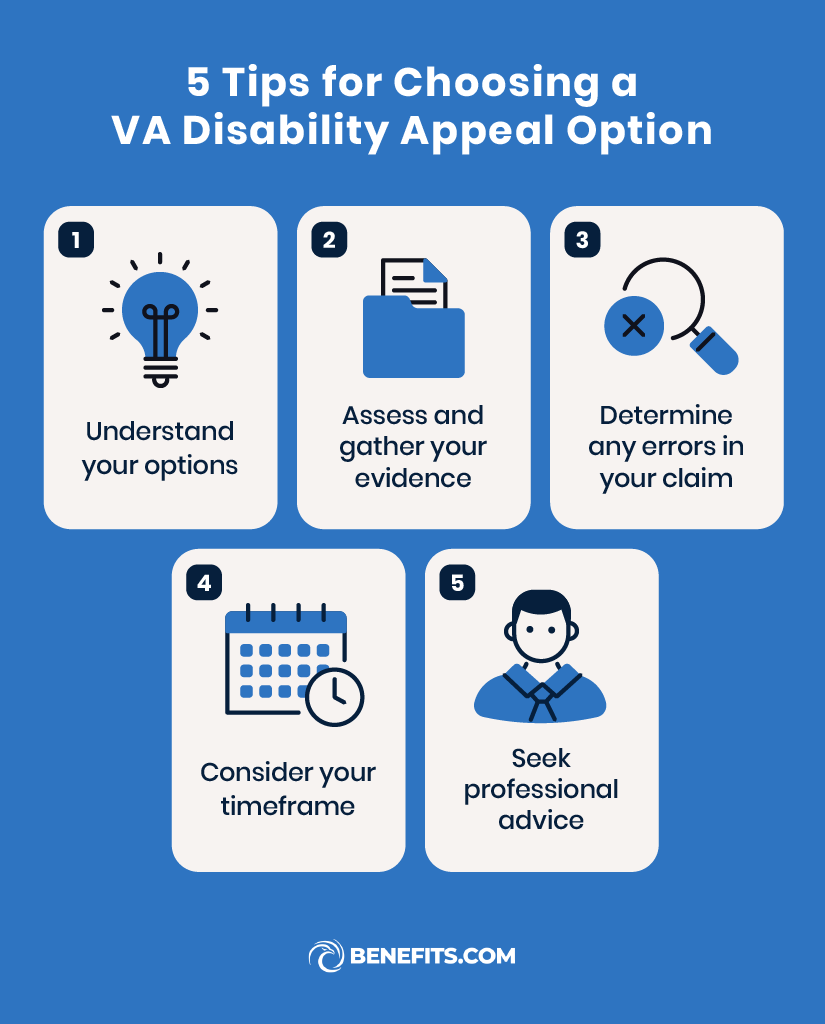If you’re a veteran whose VA disability claim is denied, you can appeal the decision in three ways under the modernized appeals system, also known as the Appeals Modernization Act (AMA).
These options include a supplemental claim, a higher-level review, or appealing directly to the Board of Veterans’ Appeals. Each path offers a different approach to getting your case reconsidered, and understanding your options is key to improving your chances of success.
In 2023, the average VA disability appeal success rate for AMA decisions was 37.9%, while legacy appeals, which follow the older, more complex process used before 2019, had a lower success rate of 33.6%. While the overall success rate ranges between 34%-38%, the strength of your appeal could push you above those averages.
Learn the different types of VA disability appeals to choose the best options and increase your chances of winning.
Types of VA Disability Appeals

The AMA offers three different paths for appealing a denied VA disability claim. Each option provides a unique approach to getting a claim reviewed, allowing you to choose the one that best fits your situation and increases the chances of a VA claims success rate.
Supplemental Claim
A supplemental claim is a good option if you have new and relevant evidence that wasn’t considered in your original VA disability claim. This appeal allows you to submit additional documentation, such as new medical records, that could strengthen your case.
One of the main advantages of a supplemental claim is that the VA will assist you in gathering this new evidence, making it easier to build a more solid case. However, if the new evidence isn’t strong enough, it can be one of the reasons for denying your VA disability claim. This can affect your VA supplemental claim success rate.
To file a supplemental claim, fill out VA Form 20-0995. You can also submit your claim online for disability compensation cases. The VA will review your new evidence and determine whether it changes the original decision.
Higher-Level Review (HLR)
Higher-level review is a great option if you believe an error was made in your claim decision but don’t have new evidence to submit. In an HLR:
- A senior reviewer will take a fresh look at your case, evaluating the same evidence that you initially presented.
- The reviewer cannot consider new evidence, so this option is ideal if you’re confident that the original evidence was either misinterpreted or mishandled.
One key advantage of HLR is that it’s typically faster than appealing directly to the Board of Veterans’ Appeals. However, the downside is that if your claim lacks strong evidence, the VA’s higher-level review success rate might be lower.
Since the implementation of the AMA through the end of FY 2023, the Board of Veterans’ Appeals has received about 279,414 appeals, accounting for 16% of all cases, while the Veterans Benefits Administration (VBA) processed 1,522,281 claims, or 84%, through either higher-level reviews or supplemental claims.
To request an HLR, you need to fill out VA Form 20-0996. You also have the option to request a one-time informal conference with the reviewer, where you can discuss any specific errors in the case.
Board of Veterans’ Appeals (BVA)
The Board of Veterans’ Appeals (BVA) is another option for veterans who want a more in-depth review of their VA disability claim. A veterans law judge (VLJ) on the board will review your case, and you can choose between three types of reviews:
- Direct review: No new evidence or hearing
- Evidence submission: Submitting new evidence without a hearing
- Hearing: With or without new evidence
One major advantage of a BVA appeal is that attending a hearing can increase your chances of success. In fact, veterans who attend a hearing and present new evidence often have a better shot at winning their appeal.
You can submit a board appeal if you want the BVA to review your case. To do so, fill out VA Form 10182.
VA Disability Appeal Success Rate Statistics
Understanding what percentage of VA appeals are successful can provide valuable insights for veterans navigating the appeal process, especially if they need to appeal to the U.S. Court of Appeals for Veterans Claims. Take a look at the key statistics for both legacy and AMA decisions from recent fiscal years.
Legacy Decisions
Fiscal year 2023 saw a success rate of 33.6% for decisions allowed, which is consistent with previous years, where the rates hovered around the low 30% range (32.0% in 2021 and 33.8% in 2020).
- The percentage of remanded decisions increased to 43.8% in 2023, indicating that many cases were sent back for further consideration, which may suggest complexities or issues that need to be addressed before a final decision is reached.
- The denial rate decreased to 16.9% in 2023, down from 21.5% in 2021, indicating a potential improvement in the overall quality of submissions or a more favorable review process.
AMA Decisions
For fiscal year 2023, the AMA decisions displayed a higher success rate of 37.9% for allowed decisions than legacy decisions. This reflects a consistent upward trend over the years, with 37.0% in 2020 and gradually increasing to 38.9% in 2022.
- The remanded cases in the AMA category decreased to 28.0%, suggesting a more streamlined process compared to earlier years, where the rate was higher (e.g., 38.1% in 2021).
- The denial rate dropped significantly to 16.7% in 2023, down from 24.2% in 2021, showing a positive trend in outcomes for veterans appealing under the AMA framework.
This progress is crucial, especially when considering the implications of a VA decision letter on a veteran’s ability to receive benefits.
How To Choose a VA Disability Appeal Option: 5 Tips

Choosing the right VA disability appeal option can feel overwhelming, but understanding your situation and the available paths will help you make the best decision. Here are five tips to guide you through the process:
- Understand your options: Familiarize yourself with the three types of appeals under the AMA — higher-level review, supplemental claim, and board appeal — so you can choose the one that fits your needs. If you opt for a board appeal, consider whether you want an in-person or virtual VA hearing, as this can affect your experience.
- Assess and gather your evidence: If you have new evidence, a supplemental claim might be your best option. Without new evidence, consider a higher-level review or board appeal.
- Determine any errors in your claim: If you believe there was an error in how your claim was handled, a higher-level review can give your case another look without submitting new evidence.
- Consider your timeframe: Some appeals, like a board appeal with a hearing, may take longer to process. If speed is important, you might want to opt for a supplemental claim or higher-level review.
- Seek professional advice: Consulting with a VA-accredited attorney or representative can help you navigate the appeals process and choose the option most likely to succeed in your case.
Frequently Asked Questions
Navigating the VA disability appeals process can raise many questions. Below are some common concerns and answers to help guide you through your appeal.
Is It Worth Appealing a VA Disability Claim?
Yes, appealing a VA disability claim is often worth the effort, especially if you believe your condition warrants a higher disability rating or if there were errors in the original decision. While the process can take time, appeals offer the chance to submit new evidence or have your case reviewed by a more experienced decision-maker.
What Is the Average Time for a VA Appeal?
The time it takes to complete a VA appeal depends on the type of appeal you choose:
- A higher-level review may take around 4-5 months.
- Board appeals with a hearing could take much longer, sometimes up to a year or more.
- Supplemental claims tend to have a faster turnaround, often within 3-4 months.
What Percent of VA Disability Claims Are Denied?
In fiscal year 2023, the denial rate for legacy VA disability claims was 16.9%, down from 21.5% in 2021. Meanwhile, AMA decisions had an even lower denial rate of 16.7%, marking a significant improvement compared to previous years. These trends indicate a positive shift in the appeals process, with more veterans successfully obtaining their benefits.
How Can I Increase My Chances of Winning My Appeal?
To improve your chances of winning a VA disability appeal, present strong, relevant evidence that supports your claim.
- If you’re filing a supplemental claim, make sure your new evidence is directly related to the reason for your claim denial.
- For higher-level reviews, carefully review your initial claim to identify any errors or missing information that could be corrected.
- If you choose a board appeal, attending your hearing can significantly improve your chances of success.
Contact Benefits.com for Assistance With Your Appeal
If you’re feeling unsure about the VA disability appeal process or need help increasing your VA disability appeal success rate, we’re here to assist. At Benefits.com, we offer the guidance and resources you need to navigate your appeal with confidence.
Whether you’re gathering new evidence for a supplemental claim or preparing for a board appeal hearing, our team can help you take the next step. Take our free medical evidence screening quiz to get an idea of the compensation you deserve.
 Benefits.com Advisors
Benefits.com Advisors
With expertise spanning local, state, and federal benefit programs, our team is dedicated to guiding individuals towards the perfect program tailored to their unique circumstances.
Rise to the top with Peak Benefits!
Join our Peak Benefits Newsletter for the latest news, resources, and offers on all things government benefits.




















